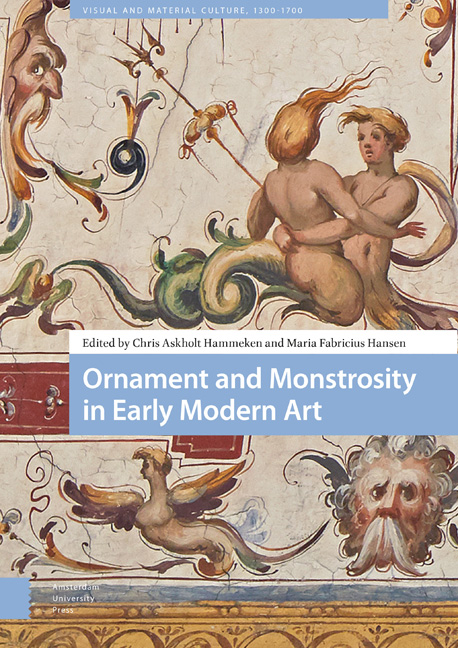Introduction
Published online by Cambridge University Press: 21 November 2020
Summary
Early Modern art – in the sixteenth century and beyond – features a remarkable fascination with ornament, both as decorative device and compositional strategy, across artistic media and genres, and in all cultural centres of the Western world. Interestingly, the inventive, elegant manifestations of ornament throughout the period often include layers of disquieting paradox, creating tensions – monstrosities even – that manifest themselves in a variety of ways. The monstrosity of ornament is brought into play through strategies of hybridity and metamorphosis or through ambiguous and discomforting treatments of scale, proportion, and space which diverge from the laws of nature. In some cases, dichotomies between order and chaos, artificiality and nature, or rational logic and imaginative creativity emerge from the decorative frameworks. Elsewhere, a sense of agitation undermines structures of statuesque control or erupts into wild, unruly displays of continual genesis.
The ultimate monstrosity is achieved when abstract, decorative forms are joined with human-naturalistic ones. Particularly in vogue in the sixteenth century are grotesques, or grottesche as they were called in Italian around 1500, that manifest themselves as monstrous ornaments par excellence (Ill. 0.1-0.5). Such colossal ornamental attitudes thrived within sixteenth-century art, expressing an interest in strange exaggeration and curious artifice while engaging in constant interaction between centre and periphery, content and ornament, or ergon and parergon, to employ a Kantian vocabulary. A parergon is a framework in the broadest sense and appears as that which surrounds or supports the ergon, which is the centrepiece, in terms of form, content, or argument. The parergon is not, however, a superfluous or superficial addition to the work, but is a precondition for the ergon.
The conventional divide between decorative and fine art often results in ornament being overlooked as accessory, an attitude that dovetails with modern notions regarding the autonomy of easel painting. Seeking to further alternatives within this field, we have invited contributions to this book that investigate the monstrous qualities of ornament within visual art from various media and genres (e.g. painting, architecture, gardens, and decorative art). The contributions are mainly anchored in the sixteenth century, but move beyond as well in order to map some of the wider perspectives of monstrous ornament within a broader historical horizon.
- Type
- Chapter
- Information
- Ornament and Monstrosity in Early Modern Art , pp. 13 - 42Publisher: Amsterdam University PressPrint publication year: 2019



